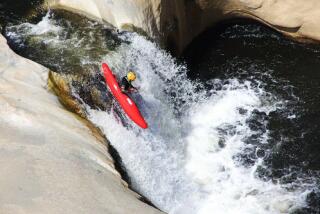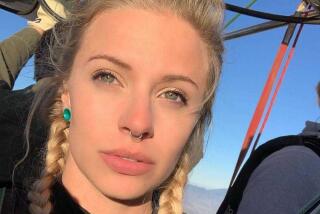Free Diving Death Spurs Safety Debate
- Share via
MIAMI — Death, like pressure and speed, is a constant companion for the few who engage in the little-known but brazen sport of “no limits” free diving.
Participants take a single deep breath, then submerge with the use of weighted sleds mounted on taut cables, plummeting hundreds of feet in about a minute -- without oxygen tanks.
At the end of the trip, the weight is dropped and the diver races to surface like a bullet. There’s no need to decompress to avoid “the bends” because no air has entered the body.
“Free diving is getting in touch with yourself. It’s very quiet and peaceful feeling, and you get to understand your body,” said Carlos Serra, president of the Miami-based International Association of Free Divers or IAFD.
“You need to know what your body is telling you and when you need to go to the surface and breathe.”
But the sport is at an apparent crossroads, divers say. The recent death of a popular world-record holder in the Dominican Republic has sparked intense debate about safety and who’s in charge.
Free diving, or breath-hold diving, existed before the days of fishing trawlers and scuba gear. Swimmers used the technique to search for the fish and shellfish that sustained civilizations in the Mediterranean, the Caribbean and other parts of the world.
Competitions emerged, and groups were organized to oversee events. Besides the depth diving or “no limits” branch of the sport, there are also “dynamic” free diving competitions where they see who can swim the farthest underwater on one breath. There are also competitions for staying underwater the longest.
The sport’s popularity is greater outside the United States. Divers participate in Internet forums and keep in contact in cyberspace, relating tales of broken records.
Annabel Briseno, 51, owns world records in dynamic free diving.
Using a weighted belt and fins, she swam more than 440 feet on one breath at a competition in Hawaii overseen by the International Association for the Development of Apnea, a Swiss-based free diving body independent of Serra’s group.
Briseno says much of a free diver’s training takes place on land, with running and breathing exercises serving as preludes to a foray into the sea or a swimming pool. In the water, divers should never train alone.
Free divers can hold their breath for up to three minutes, but blackouts from a lack of oxygen do occur.
Serra says the body can preserve oxygen by redirecting blood flow from the extremities to the main organs, such as the heart, brain and liver.
No-limits divers can regulate their heart to 20 beats per minute or less -- the normal adult resting heart rate is between 60 and 80. They also flush their sinuses and ears with water to combat the fierce effects of pressure as the diver drops.
“They put their bodies in a mode of trying to ... learn to control the urge to breathe,” Serra said.
Despite these adaptations, the “shallow water blackout” phenomena, which occurs when the brain uses up its oxygen, can cause the diver to pass out and possibly drown. It normally happens near the end of the dive, Briseno said.
“When you do blackout, it really undermines your confidence and creates a physiological fear response,” said Briseno, who has blacked out several times. “You do not want to have that panic attack when you’re free diving. It takes me about a month to get my mental status back in shape.”
The main draw for Briseno is the peace she feels while underwater.
“Once you go under the pressure, you are in a feeling of weightlessness and euphoria where you are one with the ocean,” she said. “It’s so meditative because nothing else is going on in the world at that moment. It’s like a transcendental experience.”
Serra, whose organization is among a handful that oversee free diving, is partners with one of the world’s most famous free divers, Francisco “Pipin” Ferreras.
Ferreras’ 28-year-old wife, Audrey Mestre, drowned Oct. 12 while trying to break her husband’s IAFD record of 531.5 feet achieved off Cozumel, Mexico, in 2000.
A dive to 561 feet that should have taken just three minutes lasted more than 8 1/2 minutes. Mestre’s body was limp when her husband brought her to the surface.
Mestre, of St. Denis, France, reached her target depth of 561 feet but experienced problems on her way up, Serra said. Her last dive wasn’t a record because she didn’t complete it, but the IAFD has posthumously recognized a dive to 558 feet completed by Mestre Oct. 9 in practice as a world record.
The death has ignited a dispute among divers and fans. Serra and Ferreras were inundated with criticism on Internet forums and from fellow free divers. They were blamed for failing to have adequate safety divers and medical staff, and covering up any mistakes that were made. Serra vehemently denies such criticism.
Ricardo Hernandez, who began his own free diving and spearfishing school after being fired from the IAFD two years ago, says Serra and Ferreras are hiding information.
They have not released a video made during the dive using a camera attached to the sled and failed to disclose information from computerized depth gauges secured to Mestre’s body during the dive, Hernandez said. He also questions why Ferreras had to dive in to save his wife when there were supposedly plenty of safety personnel in the water.
“There is a general outcry and an uproar in the diving community,” Hernandez said. “The video has always been shown to public after each successful record. The video will be proof of how many divers were there.
“Audrey’s death became a tragedy and it’s becoming a tragicomedy perhaps because there are so many facts people don’t know a month after she died,” he said. “Carlos and Pipin have a complete conflict of interest and their lack of disclosure is a total mockery.”
Ferreras has declined interview requests since his wife’s death, speaking to reporters only during a memorial service last month. But Serra insists there were enough safety divers and emergency medical personnel present. He says Hernandez is a disgruntled former employee who is seeking attention through “sickening” personal attacks.
He says that little information has been released out of respect to Mestre’s parents and Ferreras, who need time to grieve.
“The investigation continues. There is no cover-up. We have to understand the painful process of healing,” Serra said.
Serra said he expects to release information surrounding Mestre’s death later this month. However, he acknowledged Thursday that the sled malfunctioned and stopped while Mestre was at about 530 feet.
A safety diver stationed near the bottom of the line saw that Mestre had fainted and began taking her to the surface.
Ferreras eventually dove in with an air tank to bring his wife up.
While Mestre’s death has been felt throughout the diving community, participants say such danger is ever-present and must be accepted.
“The ocean is more powerful than you. You have to make a major peace with the ocean and realize every time you go out you can die,” said Briseno.
More to Read
Sign up for Essential California
The most important California stories and recommendations in your inbox every morning.
You may occasionally receive promotional content from the Los Angeles Times.













